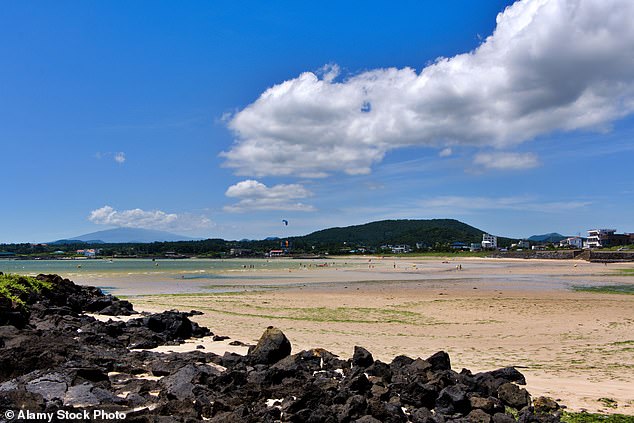I’m standing on a black lava beach besides a huge, natural, rocky volcanic sea-castle, talking to a 70 year old free-diving fisherwoman called Nari about her latest catch of conch, sea-slugs and abalone.
She’s telling me that the best place to eat them (in a spicy and delicious sauce) is in the seafood restaurant right behind me, lodged between the Pie Shop (named: ‘Pie Shop’), next to the shamanic ritual temple, the inevitable 7/11, not far from the Sex Museum.
And if all that sounds a bit unlikely, then so it should: because I am chatting with one of the haenyeo, the female seafisherfolk of Jeju – an island (population 600,000, pronounced Jay-Joo) off the south coast of Korea, a place which simultaneously manages to be beautiful, ugly, unique, peculiar, and always compelling.
It’s like an Iceland paired with a Seychelle half-covered in suburban Los Angeles and – some say, it is the most weirdly Korean place in Korea.
It is also the most popular domestic destination for Koreans, who love its fine subtropical beaches for swimming and surfing, and its historic villages, plush resorts, UNESCO-listed lava tubes, boutique hotels, and its many brilliant hiking trails in undulant forests.
All of which benefit from an accessibly mild climate when the rest of Korea freezes. Jeju is properly hot in summer.
Indeed, such is the appeal of Jeju in these parts, Seoul-Jeju is the single most popular air corridor in the world – making Jeju a brilliant, accessible diversion if you have a few days stopover in Seoul.
That’s exactly what I did.

Sean Thomas visited South Korea’s Jeju, and island off the south coast of South Korea with population of 600,000, and home to the haenyeo, the female seafisherfolk

Jeju’s Haenyeo dive as deep as 10m without oxygen tanks to collect shellfish such as abalone or sea urchins
Two days ago I was wandering Seoul’s ginseng alleys, herbal emporiums and epic seafood markets, its futuristic museums and its antique palaces.
I also made sure to enjoy Seoul’s frenetic, neon-lit nightlife in places like buzzy, studenty Hongdae, or south of the river around Gangnam (yes, that Gangnam) where uppercrust Koreans flaunt their wealth, while young, beautiful and businesslike Koreans dream up their K-pop.
But now here I am, after just a 50 minute flight, in celebrated Jeju – and with a hire car, because Jeju is not small. On the upside, it is cheap: you can feast with booze for £20.
The history of Jeju explains its unique status. For a long time it was not quite Korean, even as Koreans craved the place. It is also culturally unique: with elements of a matriarchal society.
Hence perhaps the diving women – as Nari says to me, with a mischievous grin, ‘all the men disappeared in the 18th century, to go to war – or maybe they are just a bit useless’.
Likewise, the language has a dialect of its own, and those shamanic rituals have sincerely persisted – you might catch one in a rural village.
Look for enigmatic statues of frowning men; known as ‘grandfather statues’, they date back hundreds of years and they protect each settlement from evil forces (sometimes much needed, the Japanese did bad things here in the 30s and 40s, and the brutal Korean War didn’t skip the isle).
The day ends in a suitably atmospheric Jeju spot, in the island’s glittering, surf-crashed far west.

By contrast to Jeju, Seoul, South Korea’s capital, is known for its neon-lit nightlife. Seoul-Jeju is the single most popular air corridor in the world

Some of the female freedivers that Sean met, such as the one pictured, are world famous for their ability to swim without oxygen tanks
Here, colossal windmills march toward the sea like exercising giants, their arms gyrating in Jeju’s frequent gusts (best find sheltered coasts in these conditions).
As the sun sinks low, the warm wind dies away, and an ancient stillness descends over the nearest 7/11.
Then I spy a neon sign of a spider crab above a cozy gastropub, beckoning me in for more excellent shellfish – perhaps caught this morning by a 79-year-old woman in a wetsuit.
Which is totally Jeju.
This article was originally published by a www.dailymail.co.uk . Read the Original article here. .

